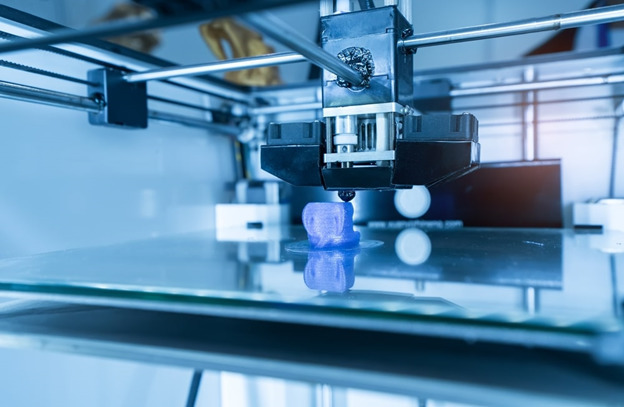Unlocking the Power of 3D Printing for Entrepreneurs
As the startup landscape continues to evolve, entrepreneurs are constantly seeking innovative ways to bring their ideas to life. One technology that has been gaining significant traction in recent years is 3D printing. Also known as additive manufacturing, 3D printing enables the rapid creation of complex shapes and designs, making it an ideal solution for startups looking to quickly prototype and test their products.
3D printing for startups offers a multitude of benefits, including reduced product development time, lower production costs, and increased design flexibility. By leveraging 3D printing technology, entrepreneurs can create functional prototypes in a matter of hours, allowing them to test and refine their designs more efficiently. This accelerated product development process enables startups to get their products to market faster, giving them a competitive edge in today’s fast-paced business environment.
Moreover, 3D printing allows startups to produce small batches or even one-off products, making it an ideal solution for companies that require low-volume production. This capability is particularly useful for startups that need to create custom or bespoke products, as it eliminates the need for expensive tooling and molds.
Another significant advantage of 3D printing for startups is its ability to facilitate iterative design. By rapidly creating and testing multiple prototypes, entrepreneurs can refine their designs and make data-driven decisions, ultimately resulting in a better product. This iterative design process is critical for startups, as it enables them to respond quickly to changing market conditions and customer needs.
As the adoption of 3D printing technology continues to grow, it’s clear that this innovative manufacturing method is poised to play a significant role in the startup ecosystem. By providing entrepreneurs with the tools they need to rapidly prototype, test, and refine their products, 3D printing is empowering startups to bring their ideas to life more quickly and efficiently than ever before.
How to Leverage 3D Printing for Rapid Prototyping and Testing
For startups, rapid prototyping and testing are crucial steps in the product development process. 3D printing for startups offers a game-changing solution for these stages, enabling entrepreneurs to quickly create and test functional prototypes. Here’s a step-by-step guide on how to leverage 3D printing for rapid prototyping and testing:
Step 1: Define Your Prototyping Goals – Before starting the 3D printing process, it’s essential to define your prototyping goals. What do you want to achieve with your prototype? What features do you want to test? By clearly defining your goals, you can ensure that your prototype meets your requirements.
Step 2: Choose the Right 3D Printing Technology – There are several 3D printing technologies available, each with its own strengths and weaknesses. For rapid prototyping, Fused Deposition Modeling (FDM) and Stereolithography (SLA) are popular choices. FDM is ideal for creating functional prototypes, while SLA is better suited for creating detailed, accurate models.
Step 3: Design Your Prototype – Once you’ve chosen your 3D printing technology, it’s time to design your prototype. Use computer-aided design (CAD) software to create a digital model of your prototype. Make sure to optimize your design for 3D printing, taking into account factors such as material selection and print orientation.
Step 4: Print and Test Your Prototype – With your design complete, it’s time to print and test your prototype. Use your 3D printing technology to create a physical prototype, and then test it to ensure that it meets your requirements. Iterate on your design as needed, making adjustments and refinements until you achieve the desired results.
Benefits of Iterative Design – One of the significant benefits of 3D printing for startups is its ability to facilitate iterative design. By rapidly creating and testing multiple prototypes, entrepreneurs can refine their designs and make data-driven decisions, ultimately resulting in a better product. This iterative design process is critical for startups, as it enables them to respond quickly to changing market conditions and customer needs.
Reducing Product Development Time and Costs – 3D printing for startups can also help reduce product development time and costs. By creating functional prototypes quickly and efficiently, entrepreneurs can test and refine their designs more rapidly, reducing the time and cost associated with traditional prototyping methods.
Overcoming Common Challenges in 3D Printing for Startups
While 3D printing for startups offers numerous benefits, it’s not without its challenges. Startups may face several pain points when adopting 3D printing, including material selection, scalability, and post-processing. In this section, we’ll address these common challenges and provide practical solutions and expert advice on how to overcome them.
Material Selection – One of the most significant challenges in 3D printing is material selection. With a wide range of materials available, it can be difficult to choose the right one for your specific application. To overcome this challenge, it’s essential to understand the properties of different materials and how they will perform in your final product. Consider factors such as strength, durability, and cost when selecting a material.
Scalability – Another challenge startups may face is scalability. As your business grows, you may need to increase your 3D printing capacity to meet demand. To overcome this challenge, consider investing in multiple 3D printers or outsourcing your 3D printing needs to a contract manufacturer. This will enable you to scale your production quickly and efficiently.
Post-Processing – Post-processing is a critical step in the 3D printing process, but it can be time-consuming and labor-intensive. To overcome this challenge, consider investing in automated post-processing equipment, such as sanding or painting machines. This will enable you to streamline your post-processing workflow and reduce labor costs.
Expert Advice – To overcome the challenges of 3D printing, it’s essential to seek expert advice. Consider consulting with a 3D printing expert or attending industry events to learn more about the latest technologies and best practices. This will enable you to stay up-to-date with the latest developments in 3D printing and make informed decisions about your business.
Best Practices – To ensure success with 3D printing, it’s essential to follow best practices. This includes designing your products with 3D printing in mind, selecting the right materials, and optimizing your print settings. By following these best practices, you can ensure that your 3D printing process is efficient, effective, and cost-effective.
Conclusion – Overcoming the challenges of 3D printing requires careful planning, expertise, and a willingness to adapt. By understanding the common challenges of 3D printing and following best practices, startups can ensure success with this innovative technology. Whether you’re just starting out or looking to scale your business, 3D printing for startups offers a wide range of benefits and opportunities.
Real-World Examples of Startups Successfully Utilizing 3D Printing
While 3D printing for startups is still a relatively new concept, there are already numerous examples of companies that have successfully integrated this technology into their product development and manufacturing processes. In this section, we’ll showcase some real-world examples of startups that have leveraged 3D printing to achieve significant benefits and results.
Example 1: MakerBot – MakerBot is a well-known startup that has been at the forefront of the 3D printing revolution. The company has developed a range of 3D printing products, including the popular MakerBot Replicator. By leveraging 3D printing, MakerBot has been able to rapidly prototype and test new products, reducing its product development time and costs.
Example 2: Formlabs – Formlabs is another startup that has successfully utilized 3D printing in its product development process. The company has developed a range of 3D printing products, including the Form 1 and Form 2. By leveraging 3D printing, Formlabs has been able to create complex and customized products, such as dental models and jewelry.
Example 3: Carbon3D – Carbon3D is a startup that has developed a range of 3D printing products, including the Carbon3D M1. By leveraging 3D printing, Carbon3D has been able to create complex and customized products, such as medical devices and aerospace components.
Benefits and Results – These startups have achieved significant benefits and results by leveraging 3D printing in their product development and manufacturing processes. Some of the benefits include:
Reduced product development time and costs
Increased product customization and complexity
Improved product quality and accuracy
Increased innovation and competitiveness
Conclusion – These real-world examples demonstrate the potential of 3D printing for startups. By leveraging this technology, startups can achieve significant benefits and results, including reduced product development time and costs, increased product customization and complexity, and improved product quality and accuracy.
The Future of 3D Printing in the Startup Landscape
As 3D printing technology continues to evolve, it’s exciting to think about the future trends and advancements that will shape the startup ecosystem. In this section, we’ll explore the possibilities of emerging technologies like 4D printing and bioprinting, and how they may impact the startup landscape.
4D Printing – 4D printing is a new technology that allows for the creation of objects that can change shape or form over time. This technology has the potential to revolutionize industries such as aerospace, automotive, and healthcare. For startups, 4D printing offers a new way to create innovative products that can adapt to changing environments.
Bioprinting – Bioprinting is a technology that allows for the creation of living tissues and organs using 3D printing techniques. This technology has the potential to revolutionize the healthcare industry, enabling the creation of customized organs and tissues for transplantation. For startups, bioprinting offers a new way to create innovative medical products and solutions.
Artificial Intelligence and Machine Learning – Artificial intelligence (AI) and machine learning (ML) are technologies that are increasingly being used in 3D printing. AI and ML can be used to optimize 3D printing processes, predict print failures, and improve print quality. For startups, AI and ML offer a new way to improve the efficiency and effectiveness of their 3D printing operations.
Internet of Things (IoT) – The Internet of Things (IoT) is a technology that enables the connection of physical devices to the internet. IoT has the potential to revolutionize industries such as manufacturing, logistics, and supply chain management. For startups, IoT offers a new way to create innovative products and solutions that can interact with the physical world.
Future Trends – As 3D printing technology continues to evolve, we can expect to see new trends and advancements emerge. Some of the future trends that we may see include:
Increased use of sustainable materials
Greater emphasis on customization and personalization
More focus on accessibility and affordability
Greater integration with other technologies such as AI, ML, and IoT
Conclusion – The future of 3D printing in the startup landscape is exciting and full of possibilities. As emerging technologies like 4D printing, bioprinting, AI, ML, and IoT continue to evolve, we can expect to see new innovations and advancements emerge. For startups, 3D printing offers a new way to create innovative products and solutions that can disrupt industries and create new markets.
Key Considerations for Startups Investing in 3D Printing Technology
When investing in 3D printing technology, startups must consider several key factors to ensure a successful integration into their existing workflows. The first consideration is equipment selection. With a wide range of 3D printing technologies and machines available, startups must choose the one that best suits their specific needs and applications. This involves evaluating factors such as print resolution, build volume, and material compatibility.
Another crucial consideration is training and support. 3D printing technology requires specialized knowledge and skills to operate effectively. Startups must invest in training their personnel to ensure they can maximize the benefits of 3D printing. This includes learning about design for additive manufacturing (DFAM), material selection, and post-processing techniques.
Maintenance is also a critical aspect of 3D printing technology. Regular maintenance is necessary to ensure the longevity and optimal performance of the equipment. Startups must establish a maintenance schedule and allocate resources to perform routine tasks such as cleaning, calibration, and software updates.
In addition to equipment selection, training, and maintenance, startups must also consider the cost of ownership. This includes not only the initial investment in the equipment but also ongoing expenses such as material costs, energy consumption, and maintenance. Startups must carefully evaluate the total cost of ownership and ensure that it aligns with their budget and business goals.
Finally, startups must consider the scalability of their 3D printing operations. As their business grows, they must be able to scale their 3D printing capacity to meet increasing demand. This involves evaluating the ability of their equipment to produce high volumes of parts, as well as the availability of materials and support.
By carefully considering these key factors, startups can ensure a successful integration of 3D printing technology into their operations. This will enable them to leverage the benefits of 3D printing for startups, including rapid prototyping, reduced product development time, and increased innovation. With the right equipment, training, and support, startups can unlock the full potential of 3D printing and drive business success.
Collaboration and Community: The Role of 3D Printing Hubs and Incubators
The 3D printing ecosystem is built on collaboration and community. Startups can benefit greatly from connecting with other entrepreneurs, experts, and organizations in the field. This is where 3D printing hubs and incubators come in – providing a supportive environment for startups to grow and thrive.
3D printing hubs are shared spaces that offer access to 3D printing equipment, software, and expertise. These hubs provide a collaborative environment where startups can work alongside other entrepreneurs, innovators, and industry experts. By sharing resources and knowledge, startups can accelerate their product development and reduce costs.
Incubators, on the other hand, are programs designed to support the growth and development of startups. They offer a range of services, including mentorship, funding, and networking opportunities. Incubators can provide startups with the necessary resources and support to overcome the challenges of adopting 3D printing technology.
One of the key benefits of 3D printing hubs and incubators is access to a community of experts and peers. Startups can tap into this network to gain valuable insights, advice, and feedback on their products and business models. This can be especially helpful for startups that are new to 3D printing and need guidance on how to integrate this technology into their operations.
Another benefit of 3D printing hubs and incubators is access to funding and investment opportunities. Many incubators have connections with investors and funding organizations that can provide startups with the necessary capital to grow and scale their businesses.
In addition to these benefits, 3D printing hubs and incubators can also provide startups with access to cutting-edge technology and equipment. This can include advanced 3D printing machines, software, and materials that can help startups to stay ahead of the competition.
Examples of successful 3D printing hubs and incubators include the likes of TechShop, a US-based chain of community-operated workshops that offer access to 3D printing equipment and expertise. Another example is the UK-based 3D Printing Hub, which provides a range of services, including 3D printing, scanning, and design.
By leveraging the resources and support offered by 3D printing hubs and incubators, startups can overcome the challenges of adopting 3D printing technology and achieve success in the market. Whether it’s access to expertise, funding, or cutting-edge technology, these hubs and incubators can provide startups with the necessary tools to thrive in the world of 3D printing for startups.
Measuring Success: Key Performance Indicators for 3D Printing in Startups
As startups integrate 3D printing into their product development and manufacturing processes, it’s essential to measure the success of these initiatives. Key performance indicators (KPIs) play a crucial role in evaluating the effectiveness of 3D printing for startups. By tracking the right metrics, startups can refine their strategies, optimize their operations, and drive business growth.
One of the primary KPIs for 3D printing in startups is cost savings. By leveraging 3D printing, startups can reduce material waste, minimize tooling costs, and eliminate the need for expensive molds and dies. Startups can track the cost savings achieved through 3D printing and compare them to traditional manufacturing methods.
Another critical KPI is time-to-market. 3D printing enables startups to rapidly prototype and test products, reducing the time it takes to bring a product to market. By tracking the time-to-market metric, startups can evaluate the impact of 3D printing on their product development cycles.
Product quality is also a vital KPI for 3D printing in startups. By leveraging 3D printing, startups can create complex geometries, customized products, and high-performance materials. Startups can track the quality of their 3D printed products and compare them to traditionally manufactured products.
In addition to these KPIs, startups should also track metrics such as production volume, material usage, and equipment utilization. By monitoring these metrics, startups can optimize their 3D printing operations, reduce waste, and improve overall efficiency.
It’s also essential for startups to establish a data-driven approach to measuring the success of their 3D printing initiatives. This involves collecting and analyzing data from various sources, including 3D printing equipment, software, and sensors. By leveraging data analytics, startups can gain valuable insights into their 3D printing operations and make data-driven decisions.
Real-world examples of startups that have successfully measured the success of their 3D printing initiatives include companies like GE Appliances, which has used 3D printing to reduce production costs and improve product quality. Another example is the startup, Relativity Space, which has leveraged 3D printing to develop and manufacture complex aerospace components.
By tracking the right KPIs and leveraging data analytics, startups can unlock the full potential of 3D printing for startups and drive business success. Whether it’s cost savings, time-to-market, or product quality, measuring the success of 3D printing initiatives is critical to achieving a competitive edge in the market.







